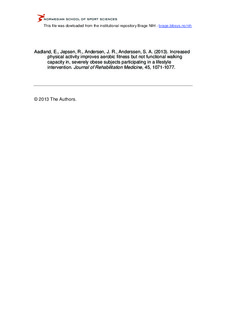Increased physical activity improves aerobic fitness but not functional walking capacity in, severely obese subjects participating in a lifestyle intervention
| dc.contributor.author | Aadland, Eivind | |
| dc.contributor.author | Jepsen, Randi | |
| dc.contributor.author | Andersen, John Roger | |
| dc.contributor.author | Anderssen, Sigmund A. | |
| dc.date.accessioned | 2014-03-06T13:16:06Z | |
| dc.date.available | 2014-03-06T13:16:06Z | |
| dc.date.issued | 2013-08-27 | |
| dc.identifier.citation | Journal of Rehabilitation Medicine. 2013, 45, 1071-1077 | nb_NO |
| dc.identifier.uri | http://hdl.handle.net/11250/191283 | |
| dc.description | @ 2013 The Authors. | nb_NO |
| dc.description.abstract | OBJECTIVE: To determine the relationship between change in physical activity level and change in directly measured maximal aerobic fitness in severely obese subjects participating in a 1-year lifestyle intervention, and to determine whether change in 6-min walk test (6MWT) could be used as an indicator of change in aerobic fitness. METHODS: Complete data on aerobic fitness (maximal oxygen consumption (VO2max) and time to exhaustion on the VO2max test), 6MWT, and physical activity (Actigraph GT1M accelerometer) were obtained for 21 subjects (mean age 42.6 years (standard deviation (SD) 11.0 years); mean body mass index 39.6 (SD 4.5) kg/m2). Multiple linear regression (controlling for change in body mass index) was used to analyse the relationships for: (i) changes in physical activity vs aerobic fitness and change in 6MWT; and (ii) changes in aerobic fitness vs 6MWT. RESULTS: Change in physical activity level was related to VO2max and time to exhaustion (partial r > 0.63, p < 0.003). No significant relationships were found between changes in aerobic fitness and 6MWT (partial r < 0.22, p > 0.351) or between changes in physical activity level and 6MWT (partial r = 0.15, p = 0.531). CONCLUSION: Increased physical activity level over 1 year resulted in increased aerobic fitness in severely obese subjects. Although the sample size was small, these results suggest that change in 6MWT might not be a good indicator of maximal change in aerobic fitness in this population. | nb_NO |
| dc.language.iso | eng | nb_NO |
| dc.publisher | Foundation for rehabilitation information | nb_NO |
| dc.subject | accelerometry | nb_NO |
| dc.subject | adult | nb_NO |
| dc.subject | anthropometry | nb_NO |
| dc.subject | exercise /physiology | nb_NO |
| dc.subject | exercise test | nb_NO |
| dc.subject | exercise therapy | nb_NO |
| dc.subject | exercise tolerance /physiology | nb_NO |
| dc.subject | health promotion | nb_NO |
| dc.subject | middle aged | nb_NO |
| dc.subject | motor activity /physiology | nb_NO |
| dc.subject | obesity, morbid /physiopathology /therapy | nb_NO |
| dc.subject | physical fitness /physiology | nb_NO |
| dc.subject | risk reduction behavior | nb_NO |
| dc.subject | walking /physiology | nb_NO |
| dc.subject | VDP::Medisinske Fag: 700 | nb_NO |
| dc.title | Increased physical activity improves aerobic fitness but not functional walking capacity in, severely obese subjects participating in a lifestyle intervention | nb_NO |
| dc.type | Journal article | nb_NO |
| dc.type | Peer reviewed | nb_NO |
| dc.source.journal | Journal of Rehabilitation Medicine | nb_NO |
| dc.identifier.doi | dx.doi.org/10.2340/16501977-1205 | |
| dc.description.localcode | Seksjon for idrettsmedisinske fag / Department of Sport Sciences | nb_NO |
Files in this item
This item appears in the following Collection(s)
-
Artikler / Articles [2096]
